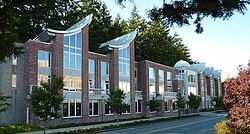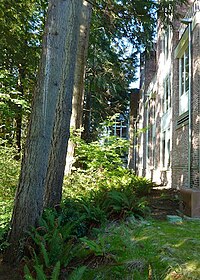From Wikipedia, the free encyclopedia
University Office Building in Vancouver, Canada
The C. K. Choi Building is an educational building on the campus of the University of British Columbia (UBC) known for its sustainable design features.[1] [2] [3] [4] [5] Institute of Asian Research . The architecture of the building implements Asian motifs.[6] [7] [8] [9]
Institute of Asian Research The Institute of Asian Research, headquartered in the C. K. Choi building, is a research institute founded in 1978 as a major Canadian research centre for Asia.
Design team C.K. Choi Memorial Bell at the building's south plaza Architects + Sustainability: Matsuzaki Wright[7] Landscape Architects: Cornelia Hahn Oberlander Structural Engineers: Read Jones Christoffersen Mechanical Engineers: Keen Engineering Co. Ltd. (now Stantec ) Electrical Engineers: Robert Freundlich & Associates Ltd. Owner: University of British Columbia, Freda Pagani, Campus Planning and Development Owner's Sustainability Advisor: Bob Berkebile, BNIM Sustainable features West elevation and preserved stand of evergreen trees providing afternoon shade Graywater trench around the building The C. K. Choi building was designed to be sustainable and energy-efficient.[10] [11]
Location: built on an existing parking lot surrounded by large trees to reduce heat gain Form: narrow profile to minimize site impact and provide natural light inside Recycling: approximately 50% of building materials were recycled or re-used Sanitation: composting toilets were initially used,[12] Stormwater: the building's gutters collect water in a tank for irrigation purposes[13] Energy: sensors turn off lights when not in use, heavy use of insulation preserves indoor temperature, steam vault utilizes waste heat Finishes: most interior surfaces use minimal material, such as unpainted metal and a lack of suspended ceilings Air quality: carpet adhesives and solvent finishes were not used in construction, to minimize air pollution Ventilation: ventilation is non-mechanical and provides fresh air from windows Heat: surplus heat radiating into the ground is collected and utilized Electricity: uses only surplus electricity from adjacent buildings[8] Exposed structure and minimal use of applied interior finishes can be seen Awards References Bibliography and External links IAR official website Archived 3 August 2018 at the Wayback Machine Gudrun, Will. A Constructive Idea, Vancouver Courier, pp. 1,4-5. Vol. 87, No.48, 16 June 1996 Alive.com - UBC Uses Eco-Sense BuildingGreen.com Cascadia Building Council Cole, Raymond J. Green Buildings: In Transit to a Sustainable World , Canadian Architect, July 1996, Volume 41, No. 7, pp. 12–13. Retrieved online October 2010.Cole, Ray, and Steiger, Michelle, Environmental Research Group, School of Architecture University of British Columbia: GREEN BUILDINGS - GREY OCCUPANTS? . Web-Proceedings: American Institute of Architects/US Green Building Council – Mainstreaming Green Conference, Chattanooga, TN, 14-19 October 1999 Cornelia Oberlander - landscape and building features Commission for Environmental Cooperation Cascadia Building Council Environmental News Network, 9 September 2008 GreenStudentU - British Columbia's Sewage-Free Building IAR - A Constructive Idea Marques, Jorge, and Pagani, Freda, and Perdue, Joanne. Process Makes Product: The C.K. Choi Building For The Institute of Asian Research at the University of British Columbia (post occupancy evaluation through December 1998) Retrieved online October 2010.Metaefficient.com MetroVancouver.org Green Value case studies Old to New - Design Guide: Salvaged Building Materials in New Construction, 3rd Edition, 2002 Prince, Richard E., UBC Department of Fine Arts. Script for an Asian Landscape , p. 18. Design for a New Millenium, ed. E. Laquian (1996). Institute of Asian Research, Vancouver. Retrieved online October 2010.Seeing With New Eyes SustainableBuilding.com Sustainability TV - A Tour of the C.K. Choi Building Treehugger.com: Vancouver Building Goes Off-Pipe University of Waterloo - case study





